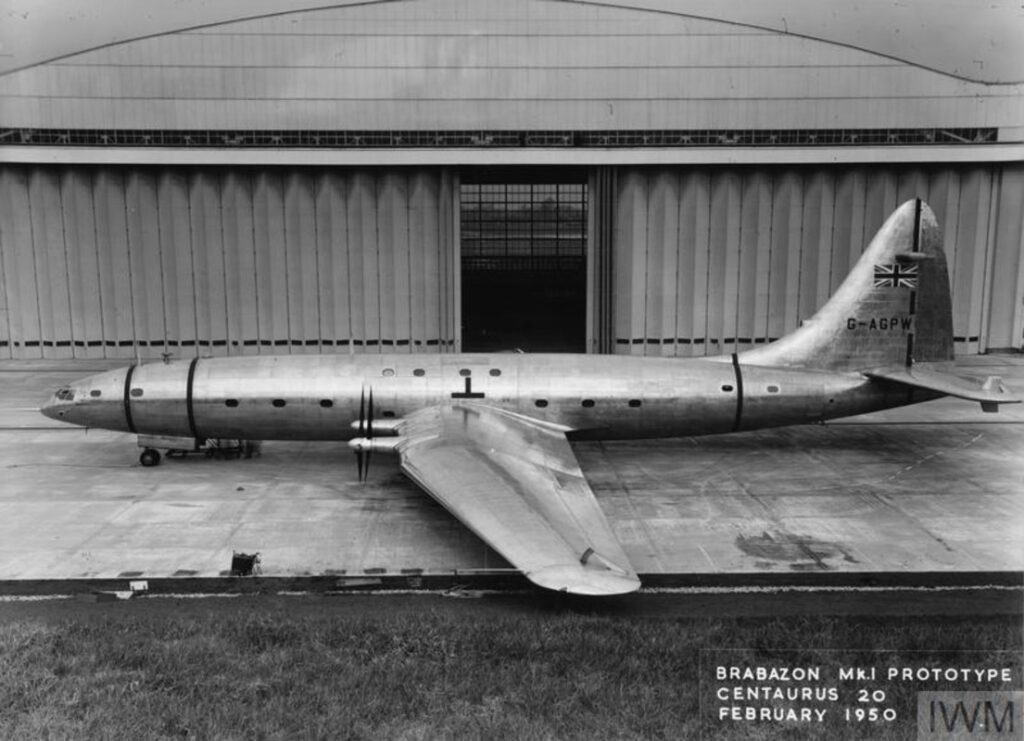When the Bristol Brabazon first rolled out onto the runway at Filton Aerodrome in 1949, it was nothing short of a spectacle. This was the largest and most ambitious aircraft Britain had ever produced, an aviation marvel designed to carry wealthy passengers across the Atlantic in unmatched luxury. Yet, despite the fanfare, innovation, and hope that surrounded it, the Brabazon never took to the skies in a commercial sense. Today, it stands as a reminder of a bold, if flawed, vision of British post-war aviation and an era that dared to dream big.
The Vision: Britain Takes Aim at Transatlantic Supremacy
Following World War II, Britain emerged with an ambition to lead in civilian aviation. Air travel, though still a luxury, was becoming increasingly viable for transatlantic journeys, and British engineers sought to capitalise on this potential. The government appointed the Brabazon Committee, chaired by Lord Brabazon of Tara, in 1942, tasked with proposing aircraft designs for various civilian needs in the post-war world. The committee’s most daring idea? A colossal, long-range airliner that could transport passengers across the Atlantic in unmatched comfort.
The Bristol Aeroplane Company was commissioned to bring this idea to life. From the outset, the specifications for what would be named the Bristol Brabazon were ambitious. Designed to carry 100 passengers in what was described as “aerial luxury”, the Brabazon would feature amenities unheard of in aviation at the time. Plans called for lounges, dining areas, and even sleeping cabins, resembling more of a luxury cruise liner than a typical aircraft. This was not to be a plane for the masses but rather a high-end experience for the elite, a floating palace of the skies.
Design and Engineering: An Aviation Feat
The Bristol Brabazon’s sheer size and scale were unprecedented. Spanning 230 feet with a wingspan greater than that of a Boeing 747, it was one of the largest aircraft ever constructed. Its eight massive Bristol Centaurus engines powered contra-rotating propellers, which offered a blend of speed and efficiency for long-haul flights. The engineering challenges involved were monumental; the aeroplane required specialised hangars, and even the Filton runway had to be extended to accommodate its size.
Inside, the Brabazon was a marvel of mid-century design. Plans included spacious, pressurised cabins outfitted with luxury furnishings, alongside large windows to give passengers a panoramic view of the skies. The aircraft’s interiors were designed with the wealthy transatlantic traveller in mind, complete with dining areas, lounges, and even a bar. The vision was to create an airliner that would make the journey itself an experience to savour.
However, this focus on luxury and comfort came at a cost: the Brabazon was incredibly heavy, which significantly impacted its range and speed. The aircraft was intended for non-stop transatlantic travel, but it could only cover shorter distances than originally anticipated, limiting its practicality and economic viability.
Trials and Testing: The Brabazon Takes to the Skies
After years of development and engineering triumphs, the Bristol Brabazon made its maiden flight on 4 September 1949. The event drew crowds of thousands, and the anticipation was palpable. As the massive aircraft lifted off the ground, Britain’s hopes for its future in commercial aviation seemed well within reach.
Despite its size, the Brabazon flew gracefully, with test pilots noting its stability and smooth handling. In total, the aircraft completed over 380 hours of test flights, yet it quickly became clear that the Brabazon’s luxury-oriented design was becoming a disadvantage. By this time, the commercial aviation landscape had shifted dramatically. The market was moving towards aircraft that prioritised efficiency and high passenger capacity over opulent comfort, particularly as transatlantic air travel became increasingly accessible.
Moreover, with an estimated cost of £3 million at a time when Britain was still recovering from the financial strain of the war, the Brabazon’s development came under scrutiny. Airlines expressed little interest in operating such a costly and impractical aircraft. As a result, no commercial orders were ever placed, and the project began to lose government support.
The End of an Era: A Dream Deferred
In 1953, after only a few years of testing, the Bristol Brabazon project was officially cancelled. The aircraft was dismantled, and its components were repurposed or sold for scrap. The decision marked a sobering end for what had once been one of Britain’s most audacious aviation ventures. The failure of the Brabazon left a lasting impact on British aviation, sparking a shift towards more practical, mass-market aircraft designs. Many of the engineers and designers who had worked on the Brabazon would go on to contribute to later successes, including the Bristol Britannia and Concorde.
Legacy: Lessons Learned and Innovations Gained
Though the Brabazon never carried a paying passenger, its legacy in British aviation should not be overlooked. The project pushed engineering boundaries and spurred advancements in materials, pressurisation, and airframe construction that would inform future aircraft designs. The experience gained by Bristol’s engineers would prove invaluable, and many of the skills developed during the Brabazon project would later find success in more economically viable aircraft.
Ultimately, the Bristol Brabazon was a product of its time, embodying post-war optimism and a determination to prove Britain’s capability on the global aviation stage. It was a gamble, but it laid important groundwork in British aeronautical engineering. Though the world would soon embrace sleeker, faster jets that prioritised speed and cost over comfort, the Brabazon’s luxurious vision of air travel remains a romantic notion in aviation history. It reminds us that sometimes, even the most ambitious dreams must bow to practicality, but not without leaving an indelible mark on history.

